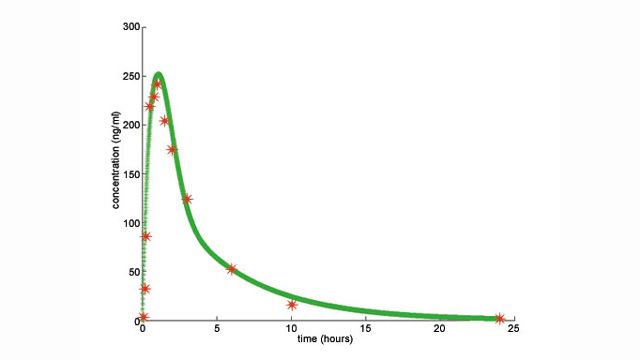Novartis Accelerates Model Development Process
“Having a single, widely used package in our industry that has many capabilities for solving ordinary differential equations as well as optimization and statistical capabilities is quite valuable. That is why we use MathWorks tools.”
Challenge
Solution
Results
- Model development streamlined
- Productivity increased through model reuse and collaboration
- Tight deadlines met consistently

Comparison of experimental and model-predicted tissue concentration of Novartis drug as a function of time following oral administration.
How can a pharmaceutical company most accurately predict the efficacy of potential drugs and determine the most promising dosing regimens for humans before conducting clinical trials?
Researchers in the Modeling and Simulation group at Novartis use MathWorks products to develop simulations that help answer these difficult questions.
“MathWorks tools help us streamline the development process by enabling us to simulate dosing regimens before clinical trials,” says Brian Stoll, senior scientist at Novartis.
Challenge
The Modeling and Simulation group at Novartis provides a wide range of services to researchers, including simulating biological systems using mathematical models to prioritize and select drug candidates and recommend dosage for clinical studies.
“We use models to make predictions in humans when we cannot do a direct measurement,” says Anna Georgieva, senior scientist at Novartis. “This is a way to incorporate existing data and guide clinical trials.”
The models typically include a set of known parameters, such as tissue volume and blood flow rate, and an unknown set, such as rate of absorption and partition coefficients. For Novartis, getting useful results depends on developing accurate models, finding values for unknown parameters, and estimating their uncertainty.
To accomplish their goals, the group required a flexible, integrated modeling environment to enable rapid simulation, optimization, and statistical analysis. This environment had to provide easy access to a wide range of capabilities, including tools for symbolic math and ordinary differential equations.
Solution
Novartis uses MATLAB® and Simulink® to create physiologically based pharmacokinetic (PBPK) models that describe the uptake and distribution of a drug given to animal species or humans over time.
They create these PBPK models using a system of ordinary differential equations, with an associated set of variables and parameters.
“For solving our systems of ordinary differential equations, the algorithms in MATLAB are more robust than other software packages I’ve used,” explains Stoll, who adds that Simulink simplifies the model development process and facilitates collaboration. “With Simulink, you can graphically organize the organs of the body physiologically. This makes it easier to explain what we’ve done to someone with expertise in biology.”
Finding values for the unknown parameters in PBPK models is a three-step process. First, the team generates predictions from the models using educated guesses for the unknown parameters. Next, they use Global Optimization Toolbox and Optimization Toolbox™ to compare those predictions to experimentally measured data and find the best values for the parameters that describe the data. Once they find the best parameter values, they use Statistics and Machine Learning Toolbox™ to conduct parameter positivity and uncertainty analyses.
The Novartis team sees the role of MathWorks tools in the drug development process potentially expanding over the next few years.
“We have support for the integration of computational modeling into various aspects of the drug development process,” Stoll says. “The adaptability and versatility of MathWorks products are a definite advantage. These products enable us to address a wide range of challenges as they arise.”
Results
Model development streamlined. “I compared the time required to develop a PBPK model using an advanced Fortran editor and debugger with the time required using Simulink,” explains Stoll. “In Simulink, the same model took approximately a third of the time to develop.”
Productivity increased through model reuse and collaboration. “We can quickly customize our models to a particular compound or biological system by changing parameters,” says Stoll. “The wide use of MATLAB in our industry also facilitates collaboration with other researchers.”
Tight deadlines met consistently. Novartis expects the Modeling and Simulation group to complete and optimize certain compound-specific models within two to three weeks. “After we create the model, a typical optimization run takes no more than a minute, so we can easily meet our deadlines using MATLAB,” Georgieva notes.